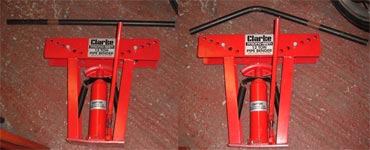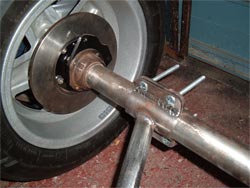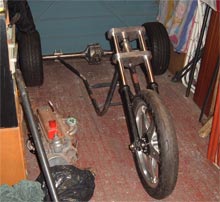
TRIKE FRAMES-THE BENDY BITS. PART 3. |
TRIKE FRAMES-THE BENDY BITS. PART 3. O.K, we’re back in the on-line Manky Monkey Motors Tricycle Emporium. |
 |
afraid to get stuck in. First off, we need to support the headstock, We’ve decided it looks best at roughly 45 degrees. That will give us plenty of straight line stability without making the steering so heavy we can’t manoeuvre it at slow speeds. The front down tubes are vertical as we intend to hang the radiator on these so we need to put matching 90 degree bends in two lengths of tube. If you’ve never seen a hydraulic pipe bender before, there should be a photo hereabouts. |
It’s a very simple machine. We bought ours new for about 85 quid. A glorified hydraulic bottle jack with a curved former on the end, sitting in a framework that supports a pair of rollers. The forming heads are interchangeable for different sizes of tube & the rollers can be moved to vary the tightness of the bend. Simply lay the tube into the former, pump up the handle & as the tube is pushed against the rollers it creates a bend. The trick is in making matched pairs of bends. For this we use an angle-form. Two flat metal straps held together at one end with a nut & bolt which can be set at the desired angle then checked against the tube as you bend it. The tube tends to spring back slightly as it’s released from the bender so we allow for that with an extra couple of pumps on the handle. A little practice on a spare piece of tube & you’ll soon get the hang of it. So we’ve measured from the headstock down to the engine mount, allowed a couple of inches extra, & bent the tube. A little of the length is lost in creating the bend but this varies depending on the diameter of tube used & the tightness of the bend. Always better to cut a tube too long than bend it & find it’s half an inch too short. On our frame the centre-line of the down tubes sits 4” in front of the engine mounts to give room for the electric radiator fan we’ll be using. We know the height of the headstock from the ground, so we can lay the two bent tubes along under the motor, blocking them up off the floor to the right height & set them at the right width to line up with the engine mounts. The vertical down tubes can then be angled inwards to meet the headstock. A little work with an angle grinder & a file & the ends are scalloped to fit neatly around the headstock tube. This is one of the most important joints on the whole frame so we’re very careful to ensure the down tubes are symmetrical & that the headstock sits square & along the centre-line of the engine. Difficult to explain. Meanwhile, at the back end, we’ve bolted the axle clamps we made last time around the axle an equal distance in from the |
 |
hubs & checked the mating face between the two halves of the clamps sits vertically. Now we need to put a second bend in each frame tube to bring them up to meet the clamps. In our case the tube needs to kick out by about 6” & up by around 4 or 5”. No easy way to explain this either, but it took us several hours of gentle bending, trying in place, head scratching, bending a little more & so on, to get it right. Even then we had to heat the second tube with a blow lamp & tweak it slightly to get it to perfectly match the first. Once that was done, the ends of the tubes were scalloped to fit against the back of the clamps then tack-welded in place, (a small, temporary weld just to hold them in position). |
 |
With the engine mounts we made earlier bolted to the motor & sitting on the frame tubes the headstock is laid back in place, measured, double-checked, tack-welded & checked again. So now we can carefully slide the front end into the headstock & we’ve got all three wheels tied together, giving us a rigid base from which to start building our frame. This has all got a bit complicated & wordy but hopefully the photos explain it a little more. We use very basic methods but take plenty of time to ensure the results are as accurate as possible. Three of us have checked every frame dimension in every direction & can honestly say it’s spot on. I’d be happy for anyone to run a spirit level & tape measure over it. And the frame. |
Alright, next time we’ll sort out the gear-box mounts & start building upwards from our bottom rails. I’m hungry after all that. Anyone remember to bring some cake? |